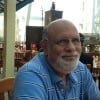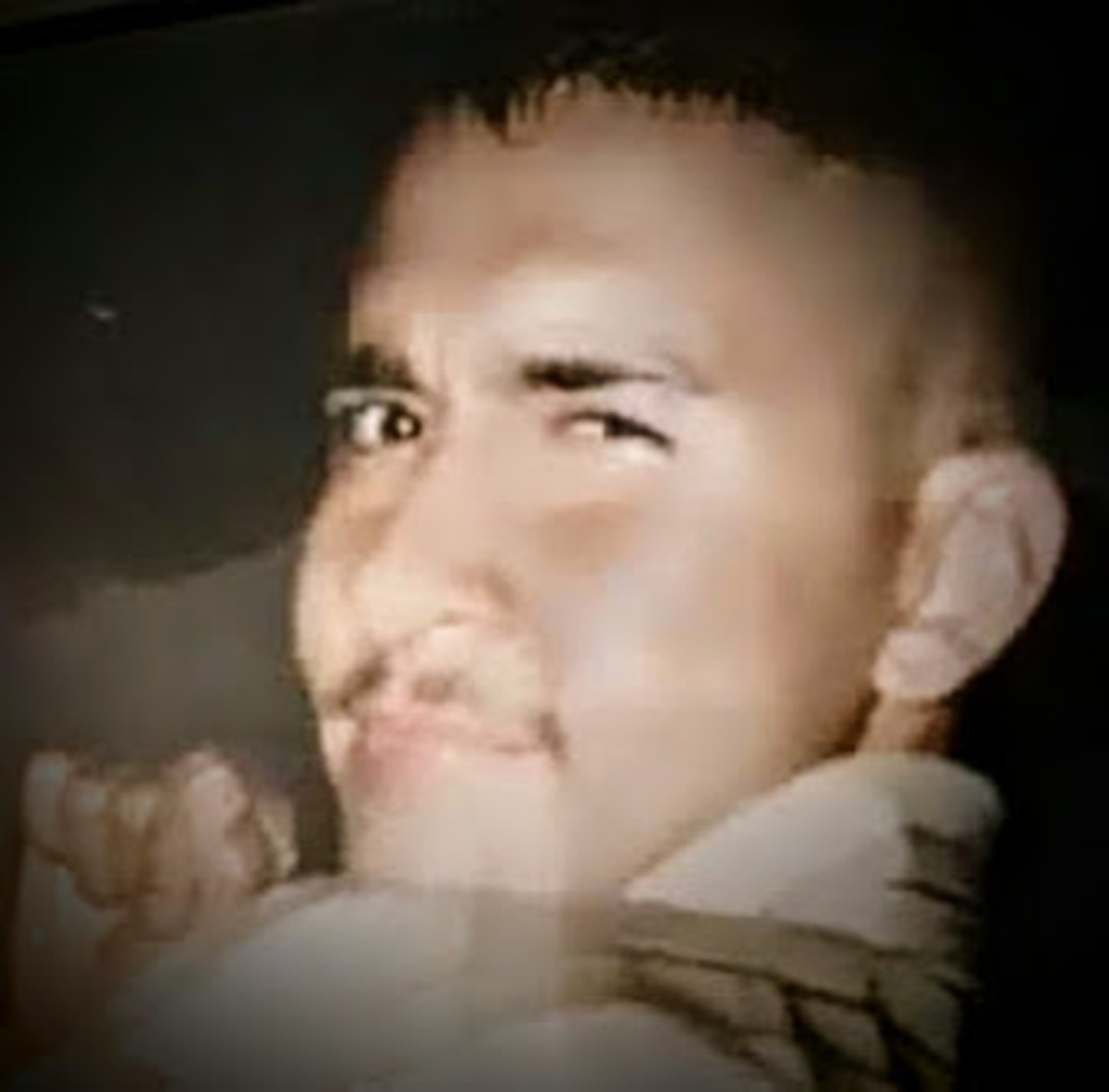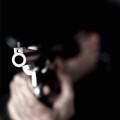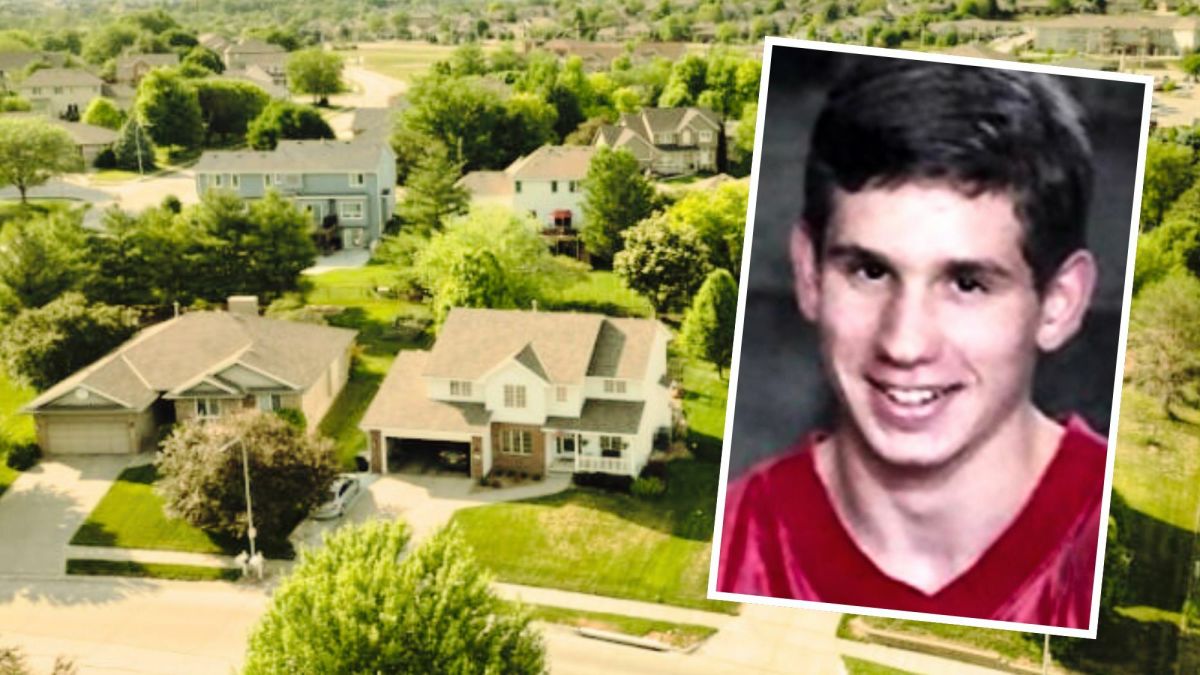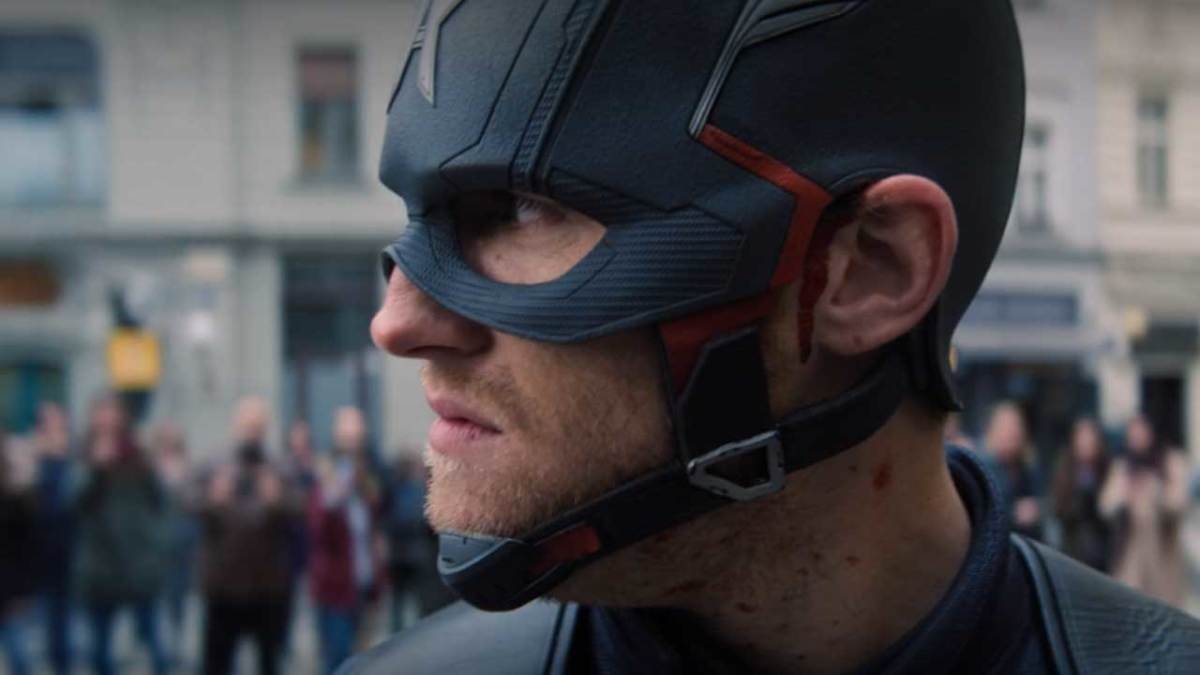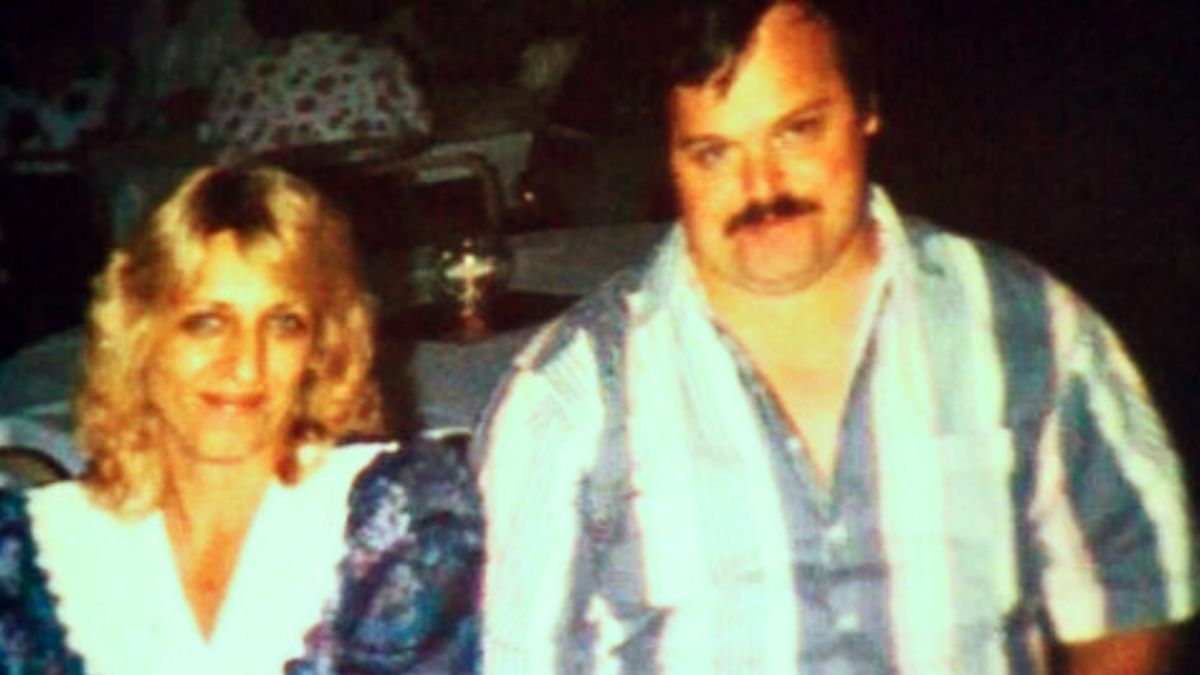American Justice:George Zimmerman Murder Trial of Trayvon Martin -> Not Guilty: Another Case Study [211*9]
RECENT EVENTS
NOVEMBER 19, 2013: THE OUTCOME OF THIS TRIAL BECOMES more relevant by the day, it seems.
Since the Not Guilty verdict in the Zimmerman-Martin trial; George Zimmerman's actions bring the unfortunate outcome of his trial, and sloppy job by the persecutors add insult-to-injury to the Martin family. In this short span of time Zimmerman as been:
- Pulled over for speeding in Texas where he was carrying concealed in his glove box
- Cited for speeding in Florida
- Threatened, assaulted, and intimidated his ex-wife with a fire arm; no charges filed as of yet.
- Arrested for threatening his pregnant girl friend with a shotgun, trashing her house, and committing battery on her. He had the audacity to call 911 after he physically threw her out of her own house and blamed it all on her. He was released on $9000 bail.
What will he do next? Stand his ground?
MANSLAUGHTER IN THE STATE OF FLORIDA
THE FOLLOWING ARE THE INSTRUCTIONS TO THE JURY in the George Zimmerman-Trayvon Martin murder trial competed on July 13, 2013 in Sanford, FL.
To prove the crime of Manslaughter, the State must prove the following two elements beyond a reasonable doubt:
1. Trayvon Martin is dead.
2. George Zimmerman intentionally committed an act or acts that
caused the death of Trayvon Martin.George Zimmerman cannot be guilty of manslaughter by committing a merely negligent act or if the killing was either justifiable or excusable homicide [self-defense]
Each of us has a duty to act reasonably toward others. If there is a violation of that duty, without any conscious intention to harm, that violation is negligence.
The killing of a human being is justifiable homicide and lawful if necessarily done while resisting an attempt to murder or commit a felony upon George Zimmerman, or to commit a felony in any dwelling house in which George Zmmerman was at the time of the killing.
The killing of a human being is excusable, and therefore lawful, under any one of the following three circumstances:
1. When the killing is committed by accident and misfortune in doing any lawful act by lawful means with usual ordinary caution and without any unlawful intent, or
2. When the killing occurs by accident and misfortune in the heat of passion, upon any sudden and sufficient provocation, or
3. When the killing is committed by accident and misfortune resulting from a sudden combat, if a dangerous weapon is not used and the killing is not done in a cruel or unusual manner.
In order to convict of manslaughter by act, it is not necessary for the State [of Florida] to prove that George Zimmerman had an intent to cause death, only an intent to commit an act that was not merely negligent, justified, or excusable and which caused death.
This was one of the charges facing George Zimmerman when he was being tried for killing Trayvon Martin one rainy night; Zimmerman was 29 and white/Hispanic, and Martin was 17 ... barely, and Black. He was also charged with 2nd Degree Murder, which includes the element of "depraved mind", e.g., racism. In addition, the State tried to get the "included" charge of Felony Murder is a killing in connection with another felony, in this case Aggravated Child Abuse; Trayvon was technically a minor. This charge was not allowed by the judge after the Defense objected.
Even though one or two jurors initially voted for the 2nd Degree Murder charge, they ultimately changed their mind and, in my opinion, for good reason. It doesn't appear to me that the prosecution came close to proving the "Depraved Mind" element required for a finding of murder in the second degree. Consequently, I will leave that for others to write hubs about.
EVENTS LEADING TO THE DEATH OF TRAYVON MARTIN
FIRST, LET ME SAY, SO THAT ALL THE READERS know where I am coming from, it is my belief that this ended up being a clear case of Manslaughter, and later I will get into why I think so. Clearly, it is not my opinion that counts, however, but that of the Jury. They did their job to best of their ability and based on the evidence as they came to understand it, found George Zimmerman Not Guilty; they didn't believe the prosecution had done enough to make its case.is This is no different than the Casey Anthony murder trial. While virtually the whole nation was convinced that Casey killed, or was somehow involved in the killing of her daughter Caylee, the same can't be said for the Zimmerman case where the country was split. Nevertheless, the Anthony jury, as I explained in a previous hub, also did its job properly. Each one stated later they believed the defendant was involved somehow with Caylee's death, but the prosecution failed to prove it beyond a reasonable doubt.
With that as a preamble, here is a brief outline of the facts of the Zimmerman-Martin case.
- Both George Zimmerman were in residence in the Resort at Twin Lakes, Sanford, Florida
- Both had a legal right to be there.
- On February 26, 2012, George Zimmerman shot and killed Trayvon Martin.
- George Zimmerman was carrying a properly licensed concealed weapon with which he used to kill Martin
- At the time of the killing, Martin was a couple of weeks past his 17th birthday and Zimmerman was 28
- Zimmerman was the Neighborhood Watch coordinator but was not on duty.
- It was a dark and fairly rainy night.
- Trayvon Martin was wearing a sweatshirt with a hood on it; a hoodie.
- George Zimmerman was leaving the neighborhood on a personal errand.
- 6:24 pm - Martin buys a bag of Skittles and an Arizona Ice Tea
- 6:54 pm - Martin calls his girlfriend
- 7:09 pm - Zimmerman, allegedly driving out of the neighborhood, calls the Sanford Police Dept.
- 7:12 pm - Zimmerman is asked by the police dispatcher if he is following Martin, the answer is "Yes", at which time the dispatcher tells Zimmerman, "OK, we don't need you to do that.", Zimmerman replies, "OK"
- ~7:12 pm: Martin's girlfriend calls Martin back.
- ~ 7:14 pm: Zimmerman ends call with dispatcher
- ~ 7:16 pm - 7:17 pm: Call between Martin and girlfriend is lost
- 7:16:11 pm: First call to 911, screams are heard
- 7:16:55 pm Shot heard on 911 call, screaming stops immediately
- 7:17 pm: First police officer arrives at Retreat at Twin Lakes
- 7:17:40+ pm: First officer arrives at crime scene.
INCREDIBLY FAST AND UNTIMELY
UNTIL I COMPLETED THIS TIMELINE FOR YOU, I had absolutely no appreciation for two things, 1) how incredibly fast this all came down once George Zimmerman hung up with the police and 2) how close the police were, physically, to having been able to stop the whole thing from happening at all. It took less than 2 minutes and 30 seconds (given the 911 call about the fight occured at 7:16:11 pm) for Zimmerman and Martin to find each other after Zimmerman hung up at 7:13:41 pm, and another 44 seconds for Zimmerman to kill Martin after the neighbors 911 call to police. Only 45 seconds later, at 7:17:40 pm, did Officer Smith, from the Sanford PD, look down at Trayvon Martin's body ... 45 seconds; if Officer Smith had arrived just 45 of your heartbeats sooner, assuming you are in good health and at rest, Trayvon Martin would have still been alive today as well as dozens of lives not destroyed.
All of the above are facts in the case, they are not denied by either the prosecution or the defense; there is physical evidence to support each one. To the charge of manslaughter, the defense had it right, what happened prior 7:13:41 pm on February 26, 2012 has little to do with Zimmerman's guilt or innocence; only what happened between 7:13:41 and 7:16:55 pm matters, for the most part. I say "for the most part" because what happened prior to this time period could have meaning in the context of the defenses to manslaughter.
We can narrow the time frame down even further when you consider the call between Martin and Rachel Jeantel on Martin's cell phone. So, what do we know about these calls? We know that:
- 6:54 pm" Rachel and Trayvon begin their conversation began. This was 15 minutes and 34 seconds before Zimmerman calls the police.
- 7:12 pm: The call gets disconnected 2 minutes and 26 seconds after Zimmerman called the police and 1 minute and 41 seconds before he hangs up
- 7:12 - 7:13 pm: Jeantel reestablishes contact with Martin; this roughly less than a minute before Zimmerman says he can't locate Martin and one minute before he hangs up with police
- 7:16 - 7:17 pm: The call with Rachel gets disconnected again
- 7:16:11 pm: The first 911 from neighbors came in and you can immediately hear someone screaming in the background. Consequently, one must deduct that the call with Rachel ended between 7:16 and 7:16:11
- Consequently, less than 2 minutes and 20 seconds passed from the time Zimmerman hangs up and to when they were fighting, given it took a few seconds from the neighbor to decide to call 911, place the call, and get connected.
- However, reenactment and my own calculation show that it took Zimmerman about 30 seconds to get from where he hung and back to the 'T' of the sidewalks where he claims Martin jumped him.
- So finally, we are left with less than a one minute and 40 second time period for Zimmerman and Martin to confront each other and begin a fight which finally gets loud enough to raise the concern of a neighbor, roughly from 17:14:20 pm to 17;16:00.
- Therefore, in that 110 second time period, Martin had to 1) approach Zimmerman from somewhere, 2) ask him "What was he following me for?", 4) get a response of "What are you doing here?" (Jeantel's testimony), 4) followed by Martin punching Zimmerman in the face (Zimmerman's testimony), 5) resulting in Zimmerman stumbling backwards (Zimmerman's testimony), and end up with Zimmerman initially on top of Martin causing Martin to tell Zimmerman to "Get off, Get off" (Jeantel's testimony) before the phone disconnected again.
From this point, according to Zimmerman's testimony
- The fight somehow moved about 19 yards (12 seconds if you walk it), where Martin managed to get on top of him in the grass,
- (Someone calls 911 at 7:16:11 pm)
- Move to where Zimmerman's head was over the sidewalk,
- Martin severely pound Zimmerman's head into the cement "dozens of times" (if you use Zimmerman's 25+ number, that would take about 13 seconds minimum, assuming Martin could pound his head at two pounds per second)
- Martin severely punch Zimmerman's head "dozens of times" more (another 13 seconds minimum)
- Slide back onto the grass
- Martin sees Zimmerman's gun and reaches for it
- Martin Utters words to Zimmerman to the effect of "Your gonna die tonight"
- Martin loses the race to the gun and gets shot by Zimmerman at 7:16:55 pm, February 26, 2012
- Martin lies dead or dying with Zimmerman on top
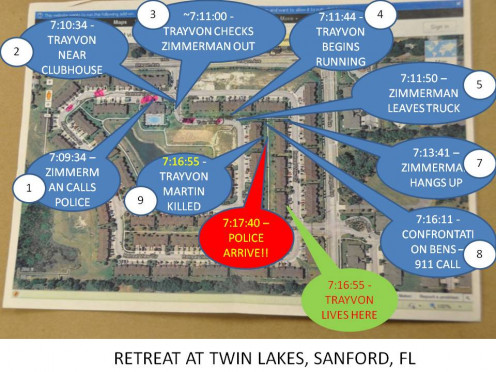
THE CASE FOR A FINDING OF MANSLAUGHTER
FIRST, LET ME SAY THAT THE JURY did their best the way they saw it and that I am not criticizing the jury's verdict; there is no question in my mind that they did their job, honestly, fairly, and faithfully. I just think they came to the wrong conclusion and if I had been on the jury, I would have argued the following:
As represented at the lead to this hub, to be found guilty of manslaughter, the State must prove two things, 1) that Trayvon Martin is dead and 2) that George Zimmerman intentionally (meaning not accidentally) caused Marin's death. Neither of these two elements are in question nor denied by Zimmerman. So, the "initial" position that must be taken is that George Zimmerman IS guilty of manslaughter.
HOWEVER, the jury instructions also contain the certain exceptions. Zimmerman CANNOT be found guilty of manslaughter if 1) Zimmerman shot Martin merely through a negligent act (Zimmerman was waving the gun around and, without meaning to, pulled the trigger killing Martin or 2) if Zimmerman's killing if Martin was either justifiable or excusable homicide [self-defense] Clearly, the act of shooting Martin by Zimmerman was intentional and therefore not "merely negligent", but, the defense argued it WAS self-defense. So now the jury must figure out if the State was able to show, beyond a reasonable doubt, that Zimmerman wasn't acting in legal self-defense when he shot Martin. I thought the State did, the jury did not and set Zimmerman free.
So, the question is "why do I think the State proved, beyond a reasonable doubt, that Zimmerman did not act legally when he shot Martin during their fight?" To act legally, causing Martin's death must be either "excusable" or "justifiable.
To be "excusable", you must:
- have had no criminal intent to do harm,
- not have acted negligently, and
- you were engaged in lawful conduct at the time of the accident
Using an example I found online assume that:
"Steve and Rich are at a bar. Steve's rowdy behavior is irritating Rich, who confronts Steve. After Rich threatens Steve, Steve hits Rich, knocking him to the ground. Rich gets up, hits Steve and Steve returns the punch. This time, Rich falls back and hits his head on a bar stool. Rich becomes unconscious and dies the next day."
In this example Steve, who was provoked and responding to Rich's attack, didn't intend to kill Rich. Under these circumstances, he accidentally killed Rich and would be entitled to an acquittal of any murder or manslaughter charges. He would still, however, be guilty of a battery.
Turn this around a bit to fit the Zimmerman-Martin case and you get:
Trayvon and George are in the community Retreat at Twin Lakes. Trayvon's behavior is making George suspicious who then starts following Trayvon and they confront each other at the 'T' in the neighborhood. After one threatens the other, Trayvon (Rich) hits George (Steve), knocking him to the ground. George gets up where Trayvon and George begin to fight with Trayvon getting the better of George. George pulls out his concealed gun and kills Trayvon.
In this case, Trayvon (Rich) didn't die by accident for George (Steve) "intended" on killing Trayvon, regardless of why. Consequently, Trayvon's death was not an accident and therefore not "excusable".
Since "excusable" is out, how about "justified" or self-defense? Here is Florida's "Stand Your Ground" law:
776.012 Use of force in defense of person.—A person is justified in using force, except deadly force, against another when and to the extent that the person reasonably believes that such conduct is necessary to defend himself or herself or another against the other’s imminent use of unlawful force. However, a person is justified in the use of deadly force and does not have a duty to retreat if:
(1) He or she reasonably believes that such force is necessary to prevent imminent death or great bodily harm to himself or herself or another or to prevent the imminent commission of a forcible felony; or
(2) Under those circumstances permitted pursuant to s. 776.013.[Which deals with dwellings]
And what is "Great Bodily Harm"? Florida courts has defined it as:
"great bodily harm ... means "great [harm] as distinguished from slight, trivial, minor or moderate harm and as such, does not include mere bruises as are likely to be inflicted in a simple assault and battery. Coronado v. State, 654 So. 2d 1267, 1270 (Fla. 2d DCA 1995)
The question is, then, was it "reasonable" for George Zimmerman to believe Trayvon Martin was about to kill him or inflict "great bodily harm" on him? My considered opinion is it was not "reasonable" for Zimmerman to believe this, given the testimony and evidence presented at his trial.
Did Zimmerman Sustain Great Bodily Harm or Facing Imminent Death?
As the defense clearly pointed out, it doesn't make any difference IF Zimmerman HAD already sustained Great Bodily Harm (GBH), but, instead does Zimmerman reasonably believe he IS GOING to sustain such harm (or face imminent death). Of course, having already sustained GBH, it becomes much easier for a jury to believe he sincerely thinks he is going to be inflicted with more. Therefore, the first question I would ask in the jury room is, "Did George Zimmerman sustain Great Bodily Harm?"
It must be obvious, based on the pictures presented,,after the blood was washed off, and the testimony of the medical examiner that Zimmerman's injuries DID NOT constitute GBH at the time he shot Martin.
As it pertains to the injuries Zimmerman sustained, the Zimmerman family physician reported:
"that Zimmerman was diagnosed with 1) a "closed fracture" of his nose, 2) a pair of black eyes, 3) two lacerations to the back of his head and 4) a minor back injury". The record further showed Zimmerman also 1) suffered bruising in the upper lip and cheek, 2) lower back pain, and 3) two lacerations on the back of his head, one of them nearly an inch long, the other about a quarter-inch long,"
Medical Examiner Valerie Rao testified to the following regarding Zimmerman's injuries:.
"They were not life-threatening. They were very insignificant,"
As defined in Coronado v State, Zimmerman had not received "Great Bodily Harm" nor is there any evidence, other than Zimmerman's statement that he was in imminent danger of being killed. So, at this point, Zimmerman doesn't qualify for the "justified" exception to Manslaughter.
Could Have George Zimmerman Reasonably Believed He Was About to Sustain Great Bodily Harm Or Was Going to Face Imminent Death?
As I previously mentioned, Florida law does say that all Zimmerman had to do was "reasonably believe" he was in danger of either one of the two reasons described above to make a justification claim. Because I, as a pretend juror, do not believe the wounds on Zimmerman rise to the level of GBH, what other evidience is there that would make me doubt the manslaughter charge is warranted. In other words, what new actions was Trayvon Martin taking to make Zimmerman think he was going to sustain GBH or think he was going to die soon?
Well, as it pertains to GBH, there is none; Zimmerman doesn't assert anything new in his original statement. The only thing Zimmerman asserts is "... "At this point I felt the suspect reach for my now exposed firearm and say "You are going to die tonight M_____ F_____". I unholstered my firearm and, in fear for my life ..."
Consider What You Must Reasonably Believe Could Have Happened For Zimmerman to be Justified in Killing Martin?
Not much, actually. The way I see it, you must reasonably believe:
- George Zimmerman did not have his gun in his hand before he said he did
- George Zimmerman was able to get to his gun the way he said he did
- Trayvon Martin knew the gun was there and was reaching for it (imminent death) or
- Trayvon Martin was going to inflict Great Bodily Harm to George Zimmerman
Again, GBH is ruled out because Martin was not about, according to Zimmerman, to do anything more harmful than what he had already been doing; which we know was no causing Zimmerman any GBH. Martin was, again according to Zimmerman, reaching for a "now exposed firearm". If that is actually true, then Zimmerman is certainly justified in shooting Trayvon Martin; and I guess this is what the jury believed. I am convinced Zimmerman lied in his statements to the police and everybody else about what Martin was doing at the time of his death. It is my considered opinion that Martin 1 did not see the gun, 2) did not reach for it, and 3) nor would Zimmerman have been able to reach it either. It is Zimmerman's own statements, plus the physical evidence, that lead me to this conclusion beyond a reasonable doubt.
Let's consider first George Zimmerman's initial statement to police the night of the killing.
WHERE TRAYVON MARTIN DIED (just to the right of the 'A' pin)
THE 'T'
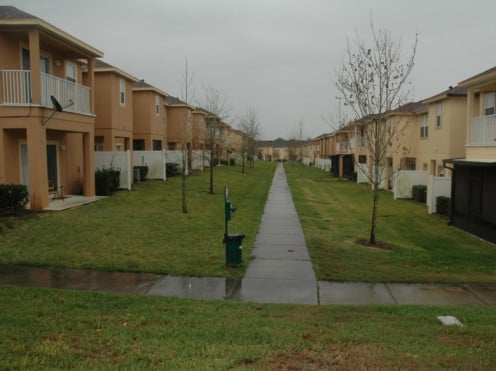
Zimmerman's Statements
Statement #1: This was delivered to Detective Singleton on the night of the shooting and provided a signed statement. In reading Zimmerman's statement, I found that:
- "... as I headed back to my vehicle, the suspect emerged from the darkness the suspect said "You got a problem?". I said "No". The suspect said "You do now". As I looked and tried to find my cellphone to dial 911, the suspect punched me in the face ..."
- Then Zimmerman wrote, "I fell backward on my back. The suspect got on top of me."
- And then, "I yelled "help" several times. The suspect told me, "to shut the f___ up" an[sic] I tried to sit up.right"
- Next, "The suspect grabbed my head and slammed it into the cement sidewalk several times. I continued to yell "help". each time I tried to sit up, the suspect slammed my head into the sidewalk.. My head felt like it was going to explode."
- Then Zimmerman writes, "I tried to slip out from under the suspect and continued to yell "help"
- Next is where Martin tried to "smother" Zimmerman. "As I slid, the suspect covered my mouth and nose and stopped my breathing"
- And now the gun; "At this point I felt the suspect reach for my now exposed firearm and say "You are going to die tonight M_____ F_____". I unholstered my firearm and, in fear for my life as he assured me I was going to kill me and fired one shot into his torso."
- After getting shot, "The suspect sat back, allowing me to sit up and said "You got me".
- Finally, "At this point I slid out from under him ,,,"
And the fight is over. So, let's consider Zimmerman's first attempt at describing what happened that night.
It is Zimmerman's contention that Martin surprises him at the 'T' of the sidewalk Zimmerman was allegedly using to get back to his car; the evidence seems to support the confrontation starting there based on his truck keys.being found between the tree, in the foreground of the above picture, and the sidewalk. But here is where I start having problems with Zimmerman's story, for If you read straight through the text of his statement, the fight started AND ENDED near or at the 'T'.
In reading Zimmerman's statement, when did it ever move beyond that point. If you believe Martin hit him in the face whole standing near the 'T', then all of the activity, including the killing of Martin happened right there, at or near the 'T'. The only indication they might of moved elsewhere is Zimmerman's claim that "I tried to slip out from under the suspect ...".
PROBLEM 1: There is one huge problem with that story, the physical evidence has the fight happening about 57 feet further into the area between the two sets of townhouses. Did Zimmerman forget where the fight happened or is he lying about because he doesn't want to admit he followed Trayvon down between the town homes?
PROBLEM 2: Zimmerman said he was afraid for his life because "... At this point I felt the suspect reach for my now exposed firearm ...". Now review the following pictures:
ZIMMERMAN'S FIREARM PLACEMENT
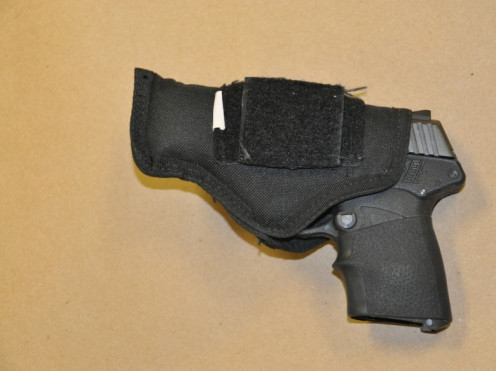
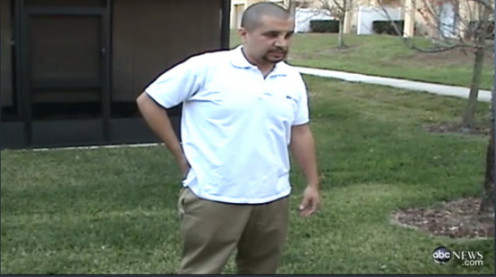
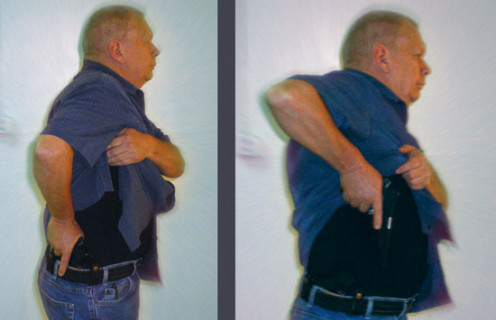
The first two photos were introduced into evidence, I don't know if the third one was or not, but it doesn't make any difference. Please look at three things, 1) where, in picture 2, Zimmerman is showing the police where his firearm was located and, 2) in picture 3, what the actor needs to do to " ...unholstered my firearm and ..." if the gun was covered by an outer garment; its a two-handed operation to be able to pull the gun from behind your back. The next picture shows the outer garment Zimmerman was wearing during the fight.
ZIMMERMAN'S ORANGE JACKET
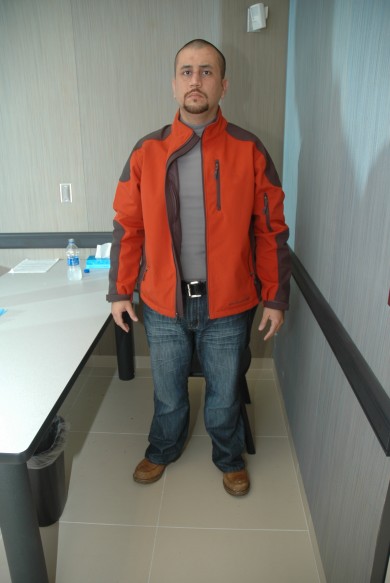
I must assume the jacket was unzipped, although on a cold, rainy night, I have to wonder. In any case, the jacket also hangs several inches below where the holster would be tucked into Zimmerman's pants, behind his back and with the pistol grip pointed toward the small of his back; away from where Zimmerman would need it to be to grab easily.
Now, picture Zimmerman laying on his back with his jacket splayed open and Trayvon Martin straddling him; remember, if the jacket were closed, the firearm would not be displayed and Zimmerman could not grab his gun. At this point, think of where Trayvon's knees would have to be, regardless how far up or down Zimmerman's torso he was sitting on; they would be on Zimmerman's jacket, wouldn't they, pinning it to the ground?
OK, next try to figure out how Zimmerman was able to scoot back far enough for Martin to be able to see the gun. How does he do that when the jacket won't go anywhere because Martin is kneeling on it; and because Zimmerman is wearing the jacket, wouldn't his ability to scoot be severely restricted? I think it would be.
Further, think of where Martin's knees would have to be for him to see, let alone reach for Zimmerman's gun. Maritn's knees would have to be below Zimmerman's belt line, it seems to me. That would put Martin's butt on Zimmerman's knees or thighs. I know Martin has long arms, but even so, look how far he has to stretch from that position to grab Zimmerman's head or cover his mouth! Now consider the next three drawings I created.
MARTIN SITTING ON ZIMMERMAN (OK, so I am no artist)
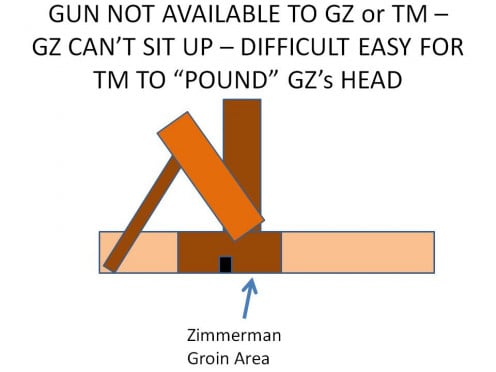
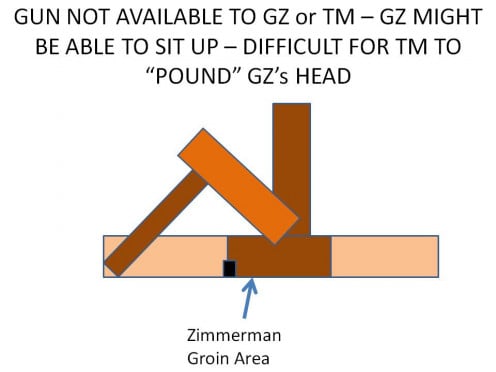
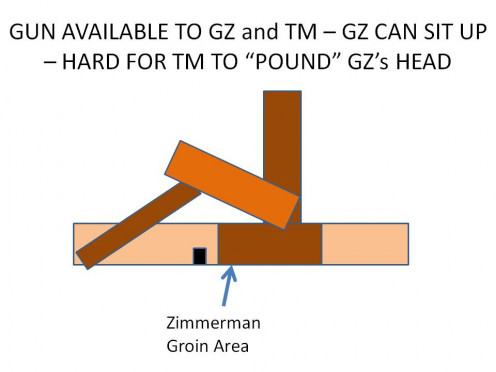
The brown, vertical rectangle is Martin sitting straight up on Zimmerman; the brown, horizontal rectangle represents Martin's legs as he kneels on Zimmerman. The lighter brown rectangle is Martin leaning forward in order to "pound" Zimmerman's head into the cement; finally the thin brown rectangle is Martin's arm (yes really). Zimmerman, of course, is the horizontal light brown rectangle and the little black square is Zimmerman's firearm.. Believe it or not, all those rectangles, except the gun, are to scale.
Now, I have two simple questions;
1) in Pictures 5 and 6, exactly how does Martin see or feel the firearm, let alone reach for it; and exactly how does Zimmerman reach way behind his back to "unholster" his weapon and simply shoot Martin, or
2) how, in Picture 7, does Martin continue to bash Zimmerman's head into the cement from that distance and angle, Zimmerman said he was doing; further, why didn't Zimmerman simply throw Martin off, given how far off-balance he would have been?
Judge Judy has one aphorism which goes "If it doesn't make sense, it isn't true."; and I buy that philosophy. This is why I have no doubt in my mind, after looking at these pictures and considering Zimmerman's inability, or extreme difficulty, to "unholster" his firearm, that Zimmerman's story doesn't make sense and therefore it isn't true, in other words, he made it up. Personally, I think Zimmerman already had his firearm out and Martin was fighting for his life!
But, what I think really happened is not important, and the same is true for the people who will continue to argue about the possibilities until hell freezes over. What does matter, on the other hand, is "do I believe the circumstances give rise to a reasonable doubt in my mind that Zimmerman actually believed, or at least reasonably believed, he was about to receive Great Bodily Harm or be killed", given the evidence and Zimmerman's statements? My answer is no.
ANOTHER SAYING FROM JUDGE JUDY IS "If you tell the truth, you don't have to remember what you said." This means to me that if you tell the truth, then the next time you tell the story, most of what you say the second time will agree with your initial statements. This implies, of course, that if the statements digress from each other then you are lying about something. From this you can properly conclude that the veracity of any of your statements is called into question, don't you see. So let's consider George Zimmerman's next statement, which is the "walk-through" of the incident.
DISCREPANCY 1: In Zimmerman's initial statement he said that shortly after first seeing Trayvon Martin walking back into the Retreat, he had "pulled over" to call the non-emergency 911 (at the club house) where he told dispatch
"... and as the dispatcher was asking for an exact location, the suspect emerged from the darkness and circled my vehicle. I didn't hear if he said anything. The suspect then once again disappeared between the back of some houses ...".
The next day Zimmerman told detectives, after he pulled over to call 911, that " ... then he [Martin] walked past me, looking at my car ..." then he describes how he lost sight of Martin after he had turned right on the connecting road and disappeared behind the club house where Zimmerman was parked taking to the dispatcher. Then he had the detective back out from the club house and had him turn right at the same intersection. He then led the detective to the spot where Zimmerman got out of the car and said,
"... and then I saw him [Martin] walk back that way [pointing down the sidewalk that 'T's into the sidewalk between the town homes where Martin was killed] and then cut through the houses; he looked back and noticed me .. he cut back through the houses ... I was still on the phone with non-emergency and then he came back ...".
At this point Zimmerman gives roughly the same circling story that he wrote in his initial signed statement. After that, Zimmerman relates "looking for an address".
What a difference!! In the first story, Martin circles Zimmerman's truck near the club house and in the second case, Martin does the circling where Zimmerman gets out of his truck to follow Trayvon. Why such a difference? Where Martin did the circling isn't really important, so why change the story? I don't know but Zimmerman's believability went down a notch or two.
DISCREPANCY 2: {I am getting wrapped around the axle in detail for this next one. Since this and following discrepancies don't change my core observation, I decided to publish what I have at this point, then complete it in real time.
SUPPORTING EVIDENCE
IF ALL YOU ARE INTERESTED IN is why I think George Zimmerman is guilt of voluntary manslaughter, there you have it and you don't have to read any further. Personally, I wouldn't need any more knowledge other than 1) Zimmerman tried to mislead the police and 2) he couldn't get to his firearm the way he said it happened. There is more, of course, which just adds more resolve to my believe of Zimmerman's guilt and that the prosecution proved it.
First, let's consider other problems with Zimmerman's initial account of what happened.
TIME PROBLEMS: Let's consider the time line in which all of this took place, for it presents several problems for George Zimmerman and his multiple versions of what happened that fateful night. Because of calls to 911 non-emergency or emergency by Zimmerman as well as the other witnesses, in addition to Martin's two conversations with his friend Rachel, we can establish several things with certainty.
We know, for example, when and where the whole incident began and ended. According to Zimmerman's walk-through, the incident probably began sometime between 1908:38 and 1909:06 (I am using military time for clarity), which is based on estimated walking time and distance, near a home at 1460 Retreat View Circle that is down the street from the Club House. Zimmerman drove past him and parked at the club house to call non-emergency 911 at 1909:34. About 45 seconds later, at 1910:18, Martin walks past where Zimmerman is parked at the club house on Retreat View Circle and "checks him out"(1). and then continues on, turning right onto Twin Trees Lane (the street Zimmerman forgot the name of; Long View Way was the third and only other street in the neighborhood) and ended, with Martin's death at 1916:55, 7 minutes and 21 seconds later, in the area between two sets or town homes which front Twin Trees, on one side, and Retreat View on the other. We also know that it is about 300 yards from where Martin walked past Zimmerman at the club house to the home where Martin stay; and 240 yards to where Martin died.
We can also establish that IF Trayvon Martin had walked, without incident, it would have taken Martin about 5 minutes to get there, assuming he walked at an average of 2 mph, For comparison, that is a little faster than my wife walks and a little slower than I walk, which is on the fast side. The world record for speed walking is around 10 mph. So, it seems to me 2 mph is a reasonable speed for someone walking at night while talking to his friend on a cellphone.
What does that tell us preliminary? That, unimpeded, Martin would have walked past the point where he was killed at 1913:24 hours (3.5 minutes before he was actually killed) and arrived at home at 1914:24 hours (2.5 minutes before he died.). And what does that tell us? That all of the other activity that took place, meaning 1) Martin stopping and staring, 2) Martin first walking down between the homes and then walking back to circle (version 2) Zimmerman's car, 3) Martin circling Zimmerman's car, then walking back to where he confronted Zimmerman, and 4) the actual confrontation itself, all took place in 3.5 minutes, IF you believe George Zimmerman's second story.!!
MAJOR DESCREPANCY #3 - "Checking Zimmerman Out Story": During the 911 call, at 1911:00 while still at the club house on Retreat View Circle, Zimmerman tells the dispatcher that Martin is coming to "check me out"; this is the only mention of this kind of activity in the recording of the call. The next day, Zimmerman contradicted the recording in a very significant way by telling the detective during the walk-through after he parked on Twin Tree Lane that Martin, after disappearing behind some homes, reappeared and proceeded to circle Zimmerman's car. So you see, the location of where Martin checked Zimmerman out moved from the club house, where it actually happened, to Twin Tree Lane, where it didn't. Consequently, Zimmerman's second "Checking me out" story is a major fabrication and mitigates against believing anything else Zimmerman reports.
MAJOR, MAJOR DISCREPANCY #4 - "The circling the car story": We know from the 911 recording that Zimmerman reports to the dispatcher at 1911:41 that Martin "... is running ..."", and at 1911:53 you can hear Zimmerman unbuckle his seat belt, open, then shut his truck door, which now apparently parked on the left side of Twin Trees Lane as you face where Trayvon Martin died. Consequently, this has to be the time that Martin circled his car. The problem is, that is impossible.
We know from the walk-through video that as the detective and Zimmerman were pulling up to where he had parked on Twin View Lane, Zimmerman told the detective he saw Martin walking down the sidewalk (in front of the truck) "and then cut through the back of the houses", meaning Martin turned right at the 'T' where the confrontation begins; this would have been around the 1911:41 time frame. Now, it is roughly 104 yards from where Zimmerman said Martin passed his car, disappeared behind the town homes and come back again to the point where Martin circled Zimmerman's car. At 2 mph, that would mean it would take Martin about 104 seconds to traverse this distance; which means Martin arrived back at Zimmerman's car at around 1913:25, 1 1/2 minutes after Zimmerman had left his truck!!!. Why did Zimmerman depart so radically from the truth? As a result, there is even less reason to believe any part of Zimmerman's account of what happened that night.
Now let me offer the the time lines from first, the 911 call, with an accompany chart, and then the walk-through video, also with an accompanying chart
AUDIO OF ZIMMERMAN'S 911 CALL
TIME LINE OF ORIGINAL 911 CALL FROM ZIMMERMAN
- < 1909:34 - Zimmerman sees Martin at 1460 Retreat View Circle (from walkthrough interview)
- 1909:34 - Zimmerman connects with 911 and pulls into club house parking
- 1910:18 - Zimmerman reports that Martin got to the club house and is just "staring" at him
- 1910:33 - 911 asks for address and Zimmerman says, among other things, "at the "club house" and that Martin is starting to come toward him.
- 1911:00 - Zimmerman says "he is coming to check me out"
- 1911:04 - 911 asks for Zimmerman tell them if Martin "does anything else"
- 1911:15 - Zimmerman makes his first "2nd degree murder" comment that "these assholes always get away" (sounds of gears shifting but no engine noise)
- 1911:41 - Zimmerman is trying to give directions for the police to the 911 operator, which he screws-up twice, and then says "s___, he is running" and 911 asks "which way is he running?"
- 1911:48 - Zimmerman answers "down toward the other entrance of the neighborhood"
- 1911:46 - 1911:53 - Sounds of Zimmerman undoing his seat belt and opening, then closing his truck door followed by wind sounds in the cell phone
- 1911:57 - 911 asks "Are you following him?"
- 1912:01 - Zimmerman responds "yes" followed by "OK, we don't need you to do that" from 911, to which Zimmerman responds "OK" although it is clear Zimmerman continues to move
- 1912:13 - 911 is getting Zimmerman's name when Zimmerman says "he ran" and 911 continues to get name and phone number
- 1912:31 - 1912:57 - 911 begins asking Zimmerman where is he going to meet the police which, Zimmerman tries but fails to do, then 911 asks "what address are you parked in front of?"
- 1912:57 -1913:13 - Zimmerman replies by saying "... it's a cut-through, so I don't know the address, at which time 911 tries to get Zimmerman's home address and ends up with Zimmerman saying "I don't know where this kid is"
- 1913:00 - I think this is where Zimmerman makes his 2nd, possibly derogatory, comment which is part of the prosecutions 2nd degree murder case. However, if this is the time, I couldn't understand either of the words ascribed to Zimmerman
- 1913:24 - With sounds that indicate Zimmerman is still walking around, he finally tells the operator "have them [the police] call me"
- 1913:41 - After a few more words, the call ends
- 1916:55 - Three minutes and fourteen seconds later Martin is shot
TIME LINE OF TRAYVON MARTIN'S LAST MINUTES - ACCORDING TO THE 911 RECORDING
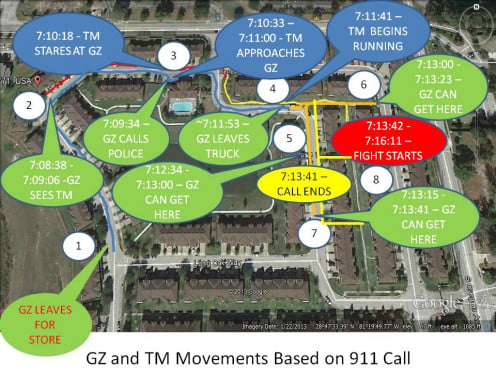
YOU TUBE VIDEO OF ZIMMERMAN WALK-THROUGH
TIME LINE, BASED ON THE ORIGINAL CALL, OF ZIMMERMAN'S 2ND INTERVIEW - THE WALK-THROUGH
- < 1909:34 - Zimmerman sees Martin at 1460 Retreat View Circle (from walk-through interview)
- <1909:34 - Zimmerman tells detective "he is just starting at me" while in front of the 1460 house.
- 1909:34 - Zimmerman connects with 911 and pulls into club house parking and they ask him where he is.
- 1910:18 - Zimmerman reports that Martin got to the club house and tells detectives that he told 911 'he just walked past me, he is looking at my car ... he is looking at the houses"
- >1910:18 - 1910:33 -
- -- Zimmerman says the dispatcher asked him "where did he go, which direction did he go in?" and Zimmerman says he replied "I don't know, I lost -- 'cause he cut down right to Twin Trees Lane (off of Retreat View) ... I can't see him."
- -- The 911 dispatcher, as Zimmerman relates it, then asked "can you get to somewhere where you can see him." to which Zimmerman says he replied "yes I can".
- -- He then has the detective pull out of the club house parking lot onto Retreat View Circle and turn right onto Twin Trees Lane. They proceed to where Zimmerman says he parked his truck on Twin Trees at the point where the sidewalk goes between the homes on his left and the next set of town homes in front of him. (The sidewalk ends on Retreat View Circle after it has curved around the complex.) (about 40 seconds from 1911:15 - 1911:55)
- -- As he and the detective stop, Zimmerman says he saw Martin walking down the sidewalk I mentioned "and then cut through the back of the houses", meaning Martin turned right at the 'T' where the confrontation begins.
- -- Zimmerman continues "he (Martin) looks back and notices me and cuts between the houses."
- -- Next Zimmerman says "he (Martin) came back! and he started walking up the grass (pointing out the front window to the left-front of the detectives car) and then came down and circled my car; I told the operator that ..."
- 1910:33 - 911 then asks "where are you", to which Zimmerman says "I don't know" and tells the detective "he couldn't remember the name of the street (one of three) ...". The operator insists on an address and Zimmerman thinks he gave them his address.
- 1911:04 - 911 asks for Zimmerman tell them if Martin "does anything else"
- 1911:44 -
- -- Zimmerman tells the investigator that the 911 operator asks for directions for the police to get to Zimmerman..Zimmerman is trying to give directions for the police to the 911 operator, which he screws-up twice,
- -- and then says he says "they (the 911 operator) asked me where he (Martin) went, what direction he went ?" to which Zimmerman replied "I don't know."
- 1911:48 - At this point Zimmerman tells the police that this when he " ... thought to get out and look for a street sign.."
- 1911:46 - 1911:53 -
- -- Zimmerman tells detectives "... so I got out of my car ..."
- -- and he proceeds to the path between the townhouses saying "... because I didn't see a street sign here, I knew if I went straight through and that would be Retreat View Circle and I could give him [the operator] and address;
- 1911:57 - [Zimmerman had actually led police to Retreat View Circle before referring to the "Are you following him" question from the dispatcher. So to keep things in sync, I have rearranged the walk-through sequence to fit the 911 call time line. The numbers give you the actual sequence.] 5) It is at this point, standing at Retreat View Circle, that Zimmerman tells the detectives that "... back there (pointing back to where they had started) they said "Are you following him?" ...
- 1912:01 - ... and I said 'yes, because I, you know, was in the area' and he said "We don't need you to do that" and I said 'OK'".
- 1912:31 - 1912:57-
- -- 2) and Zimmerman continues walking down the path toward Retreat View Circle. Zimmerman then gets to the 'T' where the fight allegedly starts and tells detectives that he "had a flashlight, but the flashlight was dead though ..."
- -- 1) he [the operator] said "give me the address of the house you are in front of " and there is no address, because of the backs of the houses"
- 911 begins asking Zimmerman where is he going to meet the police which, Zimmerman tries but fails to do, then 911 asks "what address are you parked in front of?"
- 1912:57 -1913:13 - Zimmerman replies by saying "... it's a cut-through, so I don't know the address, at which time 911 tries to get Zimmerman's home address and ends up with Zimmerman saying "I don't know where this kid is"
- -- 3) and that he told the police dispatcher "...you know what, he is gone, he is not even here ..". Zimmerman then continues to lead police to Retreat View Circle.
- -- 4) Zimmerman continues on to Retreat View Circle he says the police operator asked him "... well if he is not there, do you still want a police office?", to which Zimmerman replied "yeah".
- -- 6) and then relates the directions he gave to the dispatcher as to where the police could meet him at his truck.
- 1913:24 - With sounds that indicate Zimmerman is still walking around, he says "have them [the police] call me"
- 1913:41 - After a few more words, the call ends and Zimmerman puts his cellphone in the wrong pocket (based on what he told police a few seconds later)
- 1916:55 - Three minutes and fourteen seconds later Martin is shot
TIME LINE OF TRAYVON MARTIN'S LAST MINUTES - ACCORDING TO THE ZIMMERMAN WALK-THROUGH
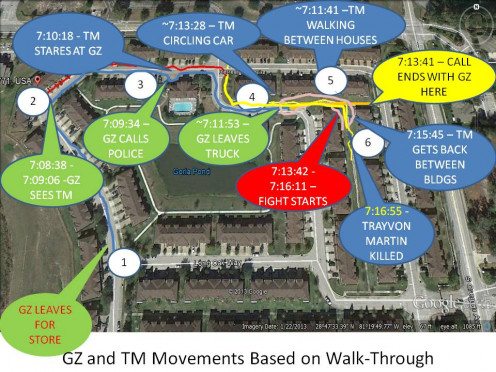
MINOR DISCREPANCIES THAT, AS A WHOLE, BECOME A MAJOR ONE
STATEMENTS TO THE 911 OPERATOR WHICH ZIMMERMAN SAID HE MADE ... BUT DIDN'T:
- (at the club house) 'he just walked past me, he is looking at my car ... he is looking at the houses"
- (at the club house, in response to a non-existent dispatcher question of "... which direction did he go ...") "I don't know, I lost -- 'cause he cut down right to Twin Trees Lane (off of Retreat View) ... I can't see him."
- (at thee club house, in response to the dispatchers non-existent question of "can you get to somewhere ...) "yes I can"
- (as Zimmerma
- n and detective were pulling up to where Zimmerman parked on Twin Tree Lane) he (Martin) came back! and he started walking up the grass (pointing out the front window to the left-front of the detectives car) and then came down and circled my car; I told the operator that ..."
- (as Zimmerman was searching for a street sign he tells the operator) "... it's a cut-through, so I don't know the address, ...I don't know where this kid is"
- (as Zimmerman is standing at the 'T' explaining things to the detective he says he told the operator this about Martin) "...you know what, he is gone, he is not even here ..".
- (after the dispatcher allegedly ask Zimmerman "... well if he is not there, do you still want a police office?", Zimmerman replies) "yeah".
STATEMENTS TO ZIMMERMAN BY THE 911 OPERATOR WHICH DIDN'T HAPPEN EITHER:
- (at the club house where Zimmerman reports Martin passing him by but not "checking him out", the operator asks) "where did he go, which direction did he go in?" (this was asked about a minute later in a different location)
- (when GZ says he doesn't know the operator says) "can you get to somewhere where you can see him."
- (after Martin circled GZ's truck, the operator asked) "... where are you?" (this was actually asked much earlier, but in the same location and after GZ said TM was running, but with no reference to the circling)
- (the operator then asks) "let me know if he does anything else" (again, the operator said this, but much earlier and in the "he is checking me out" situation at the club house)
- (as GZ is leading police to Retreat View Circle after telling dispatch he doesn't see TM, he says dispatch says) "... well if he is not there, do you still want a police office?"
- Finally, while GZ did attempt to give the dispatcher directions for police, the words, sequence, and timing are quite a bit different than that recorded on the 911 tape.
AMAZON ON THE ZIMMERMAN - MARTIN TRIAL
WHAT TO MAKE OF ALL OF THIS?
IT IS MY CONSIDERED OPINION that the State, as represented by the Sanford Police Department and the State prosecutors failed to do due diligence with regard to properly conducting the investigation, filing the charges, and prosecuting the case against George Zimmerman. The Sanford police chief, Bill Lee, was brought in 10-month earlier to clean up a racially scandalized department. He claims he was fired because he refused to arrest George Zimmerman because he felt he lacked probable cause to do so and would not violate his oath.
He told reporters that without specific evidence to refute Zimmerman's self-defense claims, Lee said, an arrest would have subjected the city to possible litigation for unlawful arrest. When asked for more specifics, Lee said,
"Well, when George Zimmerman makes the claim of self-defense we have to have some information that invalidates that or refutes that and, up to that point and continuing over the next several days, we did not have that,"
I can buy the "up to that point", meaning the night of the incident and the first interview. But ""over the next several days" makes no sense to me at all!! Why? Because "over the next several days" the Sanford investigators would have been able to compare the 911 tape with the walk-through and realize they were two different stories and not, as lead detective Chris Serino, later testified to in court, even though he initially pressed for manslaughter charges the night of the killing, to the following:
"There were some variations in his [Zimmerman's] account," he said.
"Nothing significant?" asked defense attorney Mark O'Mara.
"Nothing major," Serino said.
NOTHING MAJOR??? Give me a break! If dumb little me can run a simple time line, those experience cops ought to be able to, wouldn't you think? But for some reason, there was simply not enough reason to doubt Zimmerman's self-defense story.
Given I am not an actual detective, just a person with common sense, there may be some element of the law where Chief Lee can actually hang his hat; but it seems to me it revolves solely around whether Zimmerman's claim of self-defense is believable given:
- He was the one stalking Martin
- He was the one with the gun
- His stories do not match up in major ways with known fact which casts doubt on anything else he says
- He shot Martin
- Martin is dead.
How is that not enough to discard the self-defense claim and arrest and try Zimmerman for manslaughter? He may still be found not guilty, maybe for the very same reasons he was this time, but I hope somebody familiar with the system can tell me where my logic is wrong.
JURORS BEGIN TO SPEAK OUT
SHORTLY AFTER HANDING IN THEIR VERDICT, each of the jurors have spoken out to one degree of specificity or another.
Juror B-37 was one of the three juror's to initially vote Not Guilty and was interviewed by CNN's Anderson Cooper. She said she did not feel that George Zimmerman's "heart was in the right place" when he became suspicious of Trayvon Matins behavior but that race was not a factor. She also thought that Martin through the first punch. Juror B-37 more importantly believed the "Stand your Ground Law" did apply and since she believed Zimmerman's version of the story, that he was in fear of Great Bodily Harm or Eminent Death, he had a right to defend himself even though he was primarily responsible because he ignored the police dispatchers statement of "we do not need you to do that" [follow Martin]. Finally, she believed Trayvon Martin was partly responsible for his own death, because he (both, actually) "could have walked away."
Four of the other juror's quickly distanced themselves from Juror B-37's comments saying that she didn't speak for them.
Juror B-39 is the next to speak out, she was not part of the four who separated themselves for Juror B-37; she was also, as Puerto Rico, the only minority on the group. Her initial vote was for 2nd degree murder. While also thinking that race was not a factor, she first thought there was malice in Zimmerman's actions but quickly realized that the prosecutor had not established that element of proof and moved on to voluntary manslaughter, the lesser included offense. She says that during the course of discussions she had considered "hanging" the jury by not coming off her belief that Zimmerman had committed manslaughter. She claimed that all of the jurors felt Zimmerman was guilty of something but, in the end, could not find where the prosecution failed to prove beyond a reasonable doubt that the State had met its burden in establishing the elements of proof for manslaughter.
What was clear from both interviews is that the jurors felt "the law" (or at least the jury instructions) was too ambiguous for them to render a certain verdict. What convinced Juror B-39 to finally go with Not Guilty, like Juror B-37, was "... But as the law was read to me, if you have no proof that he killed him intentionally, you can't say he's guilty.,,,", Both women were hung up on the word "intentionally" and what the law really had in mind for the meaning of that word. To me, it means "not accidentally" or"chose to", but to the jury, it seemed to mean "wanted to" or "had no choice", If I had also excepted the latter meaning, then this hub would have a different conclusion; I would have found Zimmerman Not Guilty as well; but, I think the former meaning is correct.
RECENT EVENTS
SINCE HIS ACQUITTAL, ZIMMERMAN has been
- Stopped for speeding in Texas and issued a warning not to speed or use his gun
- 8/28/13 - Zimmerman's wife pled guilty to perjuring herself for Zimmerman; didn't bother showing up at the trial.
- 9/3/13 - Stopped for speeding in Florida and issued a $200+ citation
- 9/5/13 - Sued for divorce by his wife
- 9/9/13 - Arrested for threatening wife with his gun at her fathers house, Sheila, the wife, refused to press charges.
SO, WHAT DO YOU THINK?
Did the Jury Make the Correct Decision?
Regardless of whether You Agree or Disagree with the Jury's Decision, Do You Believe the Jury did and Honest Job?
Do YOU Think ...
Do YOU Think ...
DEMOGRAPHIC SURVEY #1
Do You Consider Yourself ...
DEMOGRAPHIC SURVEY #2
Are You ...
RELATED LINKS
- Socrates and Justice
Of the four Greek virtues -- courage, moderation, wisdom, and justice -- Socrates spends the majority of The Republic discussing justice.So why does Socrates spend so long on this one virtue? There may be several reasons, but one of the central ones - On Principle and Pragmatism VI: What is the Role of ...
Marbury v. Madison is probably not very well known amongst the U.S. citizenry even though it has had one of the biggest impacts on American lives in our history. - What is So Wrong with Justice in America That We Wan...
The one thing America and dictatorships, tyranny's, and most third-world countries have in common is its love affair with the death penalty. Georgia recently executed Troy Davis, for murdering a Savannah, GA police officer. The problem is, there was - American Justice: The Use of the Death Penalty: Whe...
This is a case of a murder that was beyond a reasonable doubt; but, that is not what this hub is about. It is about another of the murderer's victims;shot in the head, expected to die, but didn't. He made extremely heartfelt pleas NOT to execute his - American Justice: Casey Anthony Murder Trial of Daug...
Public outrage in America against defense counsels doing their Constitutional jobs is not new in America; I suspect their are a few on the Right that actually think the right to a defense counsel guaranteed in the Constitution was a mistake. Like O.J - On Principle and Pragmatism VII - Waiting for Justic...
The Casey Anthony murder trial brought into focus the good and the bad about the American Justice system. The bad was made evident by the reaction of the public to the jury's verdict; the good is how the jury arrived at their verdict and how they kep
